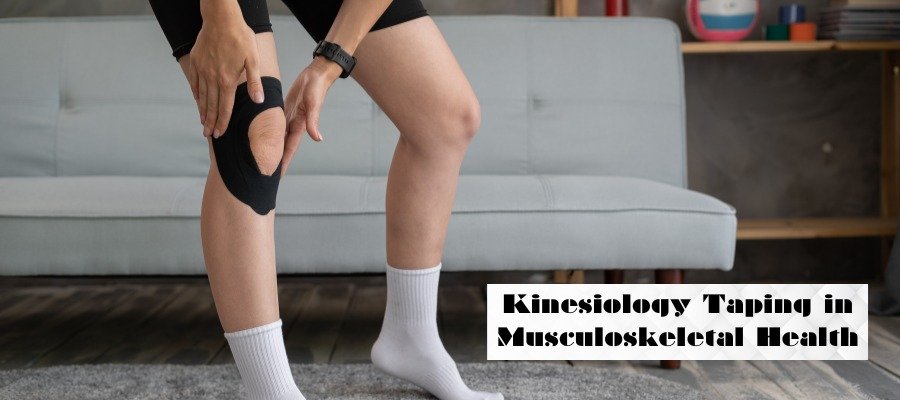Introduction
In the realm of musculoskeletal health and sports performance, a multitude of techniques and therapies have come to the fore, aimed at preventing injuries, managing pain, and facilitating rehabilitation. Among these, kinesiology taping has emerged as a prominent and colorful contender. Beyond its eye-catching appearance on athletes and those with injuries, kinesiology tape serves a more profound purpose. In this blog, we embark on a journey into the world of kinesiology taping and its profound advantages in the realm of musculoskeletal health.
Understanding Kinesiology Taping
Kinesiology tape, also affectionately known as K-tape, is a supple, elastic strip made from cotton with an adhesive backing. It is meticulously engineered to mirror the flexibility of human skin, rendering it comfortable to wear and enabling an unrestricted range of motion. This tape is deftly applied directly to the skin, serving as a source of support, stability, and pain relief, all without impinging on movement.
Benefits of Kinesiology Taping
Pain Alleviation
Kinesiology taping emerges as a potent tool for pain management. By gently elevating the skin, it mitigates the pressure on pain receptors. This mechanism proves effective for individuals grappling with both acute and chronic musculoskeletal pain, including issues such as lower back pain, knee discomfort, and shoulder aches. Kinesiology taping, often referred to as “k-tape,” is used to provide support and facilitate healing in various musculoskeletal conditions.
Some conditions in which kinesiology taping can be beneficial include:
Muscle Strains: K-tape aids in reducing muscle strain and fatigue by furnishing support and enhancing blood circulation to the affected area.
Joint Instability: It serves as a stabilizing force for joints that may exhibit hypermobility or a propensity for injury, such as the knee, shoulder, or ankle.
Tendonitis: K-tape is a valuable ally in alleviating the pain and inflammation that often accompany tendonitis, offering gentle support to afflicted tendons.
Swelling and Edema: The tape contributes to the reduction of swelling and edema by delicately lifting the skin and stimulating lymphatic drainage.
Postural Issues: K-tape aids in the cultivation of better posture by providing tactile feedback, assisting individuals in maintaining proper alignment.
Carpal Tunnel Syndrome: It extends respite from the symptoms associated with carpal tunnel syndrome, delivering support to the wrist and alleviating pressure on the median nerve.
Rotator Cuff Injuries: In cases of rotator cuff injuries, k-tape can be enlisted to offer support and stability to the shoulder.
Shin Splints: For individuals enduring the discomfort of shin splints, k-tape can be instrumental in providing relief by lending support to the calf muscles and diminishing stress on the shin.
Back Pain: Applied to the back, k-tape supplies support and comfort, particularly in cases of mild to moderate back pain.
Plantar Fasciitis: K-tape comes to the aid of those suffering from plantar fasciitis, rendering support to the arch of the foot
It’s important to underscore that while kinesiology taping can yield substantial benefits in these conditions, it should be deployed as part of a comprehensive treatment strategy under the guidance of a proficient physical therapist. The correct technique for applying k-tape is precise and should be executed accurately to achieve the desired therapeutic outcomes.
- Muscle Support: The inherent elasticity of kinesiology tape provides invaluable support to fatigued or enfeebled muscles. Athletes frequently harness kinesiology tape to augment muscle function, mitigate the risk of muscle strains, and expedite their recovery from injuries.
- Enhanced Circulation: When expertly applied, kinesiology tape fosters superior blood and lymphatic flow in the taped region. This facilitates the reduction of swelling and inflammation, which are pivotal elements of the healing process.
- Preventing Injuries: For athletes and individuals with active lifestyles, kinesiology tape acts as a preemptive measure against injuries. By delivering supplementary support to susceptible areas like the ankles, knees, and shoulders, it also plays a pivotal role in preserving the proper alignment of joints during strenuous activities.
- Expanded Range of Motion: In stark contrast to conventional athletic tape, kinesiology tape affords an unobstructed range of motion. This characteristic is particularly advantageous for athletes who must maintain flexibility while convalescing from injuries.
Application Techniques
Precision in the application of kinesiology tape is paramount to harness its maximal benefits. It necessitates a profound understanding of anatomy and the nuances of taping techniques.
- Pristine and Dry Skin: Prior to tape application, it is imperative to ensure that the skin is immaculate and free of moisture. This provides the ideal canvas for optimal adhesion.
- Tension and Stretch: The degree of stretch conferred upon the tape can fluctuate contingent on the desired effect. Muscle support may demand greater stretch, whereas pain relief typically calls for less stretch.
- Direction of Traction: The direction in which the tape is applied can significantly influence the anticipated outcome. Taping techniques may encompass the application of tape along the muscle, across the muscle, or following a specific pattern tailored to address a particular issue.
Conclusion
Kinesiology taping stands as a versatile and invaluable instrument in the realm of musculoskeletal health. Whether you’re an athlete endeavoring to elevate your performance or an individual seeking respite from pain, kinesiology tape emerges as a non-invasive and efficacious solution. However, it is imperative to remember that while kinesiology tape can provide support and pain relief, it should not supplant the importance of accurate medical diagnosis and comprehensive treatment strategies.
At Ephysioneeds Academy, we offer comprehensive training for physiotherapists looking to progress their skills. Our courses include dry needling certification, advanced physiotherapy techniques, and sports injury treatment. Our rehabilitation certification and physiotherapy training online provide flexibility and depth. We moreover specialize in manual therapy courses and soft tissue therapy certification. Explore our sports fellowship in physiotherapy and detailed A-Z knee and shoulder treatment courses. Additionally, the Tapedia Taping Encyclopedia is an essential resource for mastering taping techniques.

